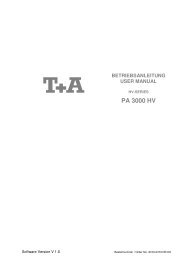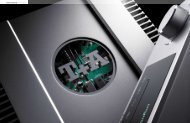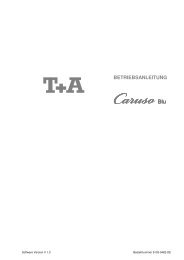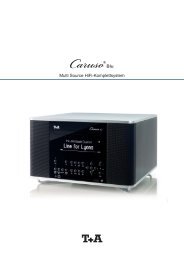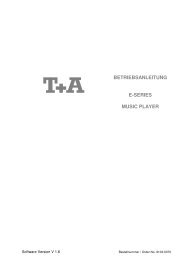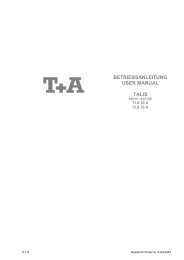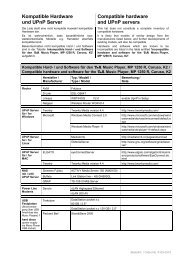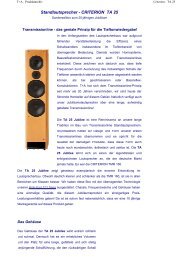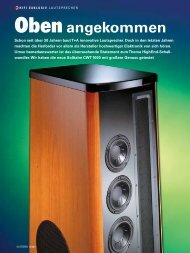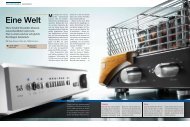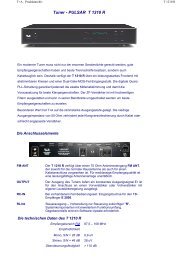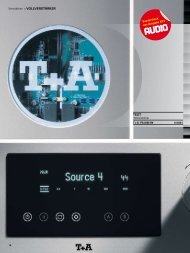CD player - PULSAR CD 1500 R - T+A Elektroakustik
CD player - PULSAR CD 1500 R - T+A Elektroakustik
CD player - PULSAR CD 1500 R - T+A Elektroakustik
Create successful ePaper yourself
Turn your PDF publications into a flip-book with our unique Google optimized e-Paper software.
<strong>T+A</strong> - Produktarchiv<br />
ANALOG OUT Asymmetrical analogue output for use with co-axial cables<br />
terminating in Cinch plugs.<br />
VOLUME CONTROL This slide switch can be used to set the <strong>CD</strong> <strong>1500</strong> R to either of<br />
two modes of operation: in the ‘OFF’ position the unit is in <strong>CD</strong><br />
<strong>player</strong> mode. In this mode the volume control of the unit does<br />
not affect the overall volume, but instead adjusts the output<br />
level. If the switch is set to ‘ON’, the unit operates in preamplifier<br />
mode. In this mode the volume control on the unit<br />
controls overall volume, and mirrors the volume control on<br />
the remote control handset.<br />
ON / OFF This slide switch switches the digital outputs (optical and coaxial)<br />
on / off.<br />
DIGITAL OUT (optical) Digital output for use with light-pipe cables.<br />
DIGITAL OUT (co-axial) Co-axial digital output for use with co-axial cables terminating<br />
in Cinch plugs<br />
RC IN RC input socket for connection to an "R"-series pre-amplifier,<br />
integrated amplifier or receiver.<br />
Standard-filter (long FIR-filter)<br />
The long FIR-filter is the standard oversampling filter used in digital technology.<br />
Advantages: Extremely linear frequency response in the audible range, very high stop band<br />
attenuation, linear phase, constant group delay.<br />
Filter 1 (short FIR-filter)<br />
The short FIR-filter has similar characteristics to the long FIR filter, but very much lower<br />
coefficient (160) and consequently considerably lower pre- and post-echoes. Advantages:<br />
Extremely linear frequency response in the audible range, high stop band attenuation, linear<br />
phase, constant group delay.<br />
Filter 2 (IIR-filter)<br />
This filter is a classic 8th order IIR-filter. It exhibits absolutely no pre-echo effects, albeit a<br />
slight tendency to post-echo. This is also a feature of natural instruments, and in any case<br />
the post-echo is usually masked by the normal audible signal. Advantages: No pre-echo at<br />
all, no treble loss, very high stop band attenuation.<br />
Filter 3 (Bezier- / IIR-filter)<br />
This combination circuit consists of three cascaded filters: a Bezier filter, an IIR filter and a<br />
second Bezier filter. It represents a good compromise between transient response and<br />
frequency response. Advantages: Virtually no pre-echo, minimal post-echo (in masking<br />
range), relatively flat frequency response, no pronounced treble loss.<br />
Filter 4 (Bezier-filter)<br />
The Bezier-filter is the ideal filter in terms of transient response, virtually no pre- or post-<br />
echo, linear phase, slight treble roll-off at 20 kHz. Advantages: Optimum transient response,<br />
linear phase, constant group delay.<br />
2-way converter<br />
Multi-bit and Sigma/Delta (1-bit) converters both offer their own unique advantages in terms<br />
of sound quality.<br />
Multi-bit converters provide a particularly powerful but rounded sound, especially in the bass<br />
part of the frequency range, whereas Sigma/Delta converters offer unexcelled fine detail<br />
<strong>CD</strong> <strong>1500</strong> R



